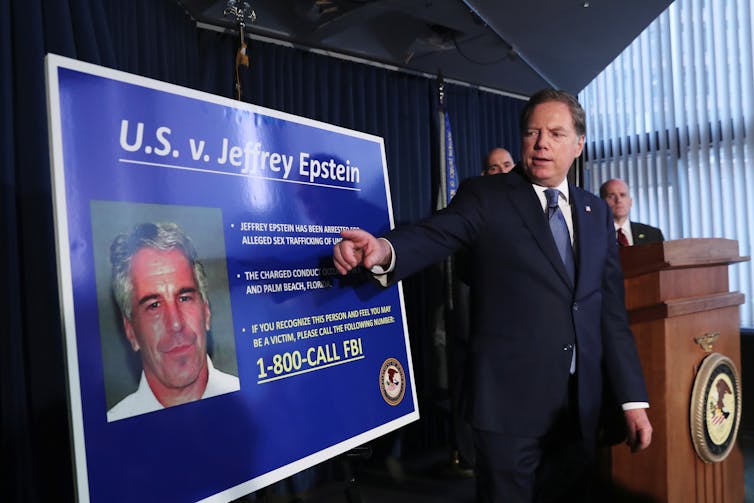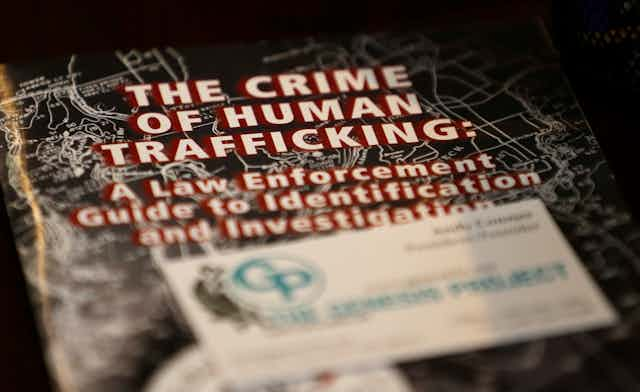Although Jeffrey Epstein, who died on Aug. 10, may be the current face of sex trafficking, buying and selling youth and adults for sex is a more common practice for everyday people in the U.S., mostly men.
Experts have a term for what Epstein is accused of doing: sex trafficking.
The Trafficking Victims Protection Act, passed in 2000, defined a sex trafficking victim as any adult involved in a commercial sex act that was induced by force, fraud or coercion or in which the person induced has not yet reached the age of 18.
The federal government and advocates refer to human trafficking generally as modern-day slavery.
I have spent the last 25 years studying sex trafficking. Because the idea of “freedom” is deeply rooted in the American dream, I believe that this population deserves more of the public’s attention.
Who purchases sex?
Human trafficking is a business with supply and demand: The supply is the victims, and the demand is the customers.
But who are the customers?
When it comes to youth, it’s a myth that the creepy pervert living under the bridge is buying our youth for sex. “John” is employed and living next door to you.
The most common procurers of sexual services are employed men with enough disposable income to engage in these activities, which typically cost from US$15 to over $1,000.
In 2014, the Urban Institute, a D.C. think tank, studied the underground illegal commercial sex trade across seven cities. They estimated that, in 2007, customers in these cities spent between $39.9 million and $290 million on sexual activities. In those cities, customers handed each trafficker between $12,000 and $32,833 per week.
One review of 21 studies estimated that 15% to 20% of American men had purchased sex at least once. It’s difficult to ascertain the number of victims customers purchased for sex or how many knew they purchased sex trafficking victims.
Comparing men arrested for buying sex with a nationally representative sample of men, one study found that men who purchased sex were more likely to be educated. They were also slightly more likely not to be married.
More specifically, my team conducted a study of 115 women in Ohio that had previously been child sex trafficking victims and 43 who were current adult sex trafficking victims.
We identified their customers as being male drug dealers, members of law enforcement, lawyers, construction workers, truckers, businessmen, social workers, pastors, city employees and more.
Purchasing sex online has also become big business. In a study across 15 metropolitan cities, on average, 1 out of every 20 males over the age of 18 found a sex ad and engaged by texting or calling to arrange an encounter.

Reframing sex traffickers and customers
In movies like the blockbuster “Taken,” family man and retired CIA agent Liam Neeson reluctantly allows his daughter to take a trip out of the country, where she is ultimately trafficked into the sex trade.
The movie perpetuates the idea that the biggest risk for the trafficking of our daughters is in sending them abroad, like Neeson’s character did in the movie.
In reality, because of U.S. purchasing power and demand for sexual services, the risk is right here. Many U.S. victims of sex trafficking are trafficking right here in the U.S.
American youth who are successfully trafficked often come from a history of abuse or have run away from home.
Since the passing of the Trafficking Victims Protection Act in 2000, the U.S. has made progress in fighting sex trafficking. Both the federal government and states have passed laws that shift the blame away from vulnerable youth and adults onto traffickers and customers and attach stiff penalties for sex trafficking crimes.
As part of that progress, the language surrounding these crimes has changed. Anti-trafficking advocates no longer call victims “juvenile prostitutes,” but victims of commercial sexual exploitation or sex trafficking victims. Social services organizations treat them like children in need of care, as dictated by safe harbor laws passed across states. Anti-trafficking advocates and law enforcement no longer call the men that sell children “pimps,” but “traffickers.”
But I think that the public view on sex trafficking, particularly of youth, has yet to catch up. Many Americans still call men that purchase sex with youth “johns.” In reality, they are “child molesters” or “sexual predators.”
At the moment, the public has fixated its hatred of sex trafficking onto one man, Epstein, who purchased and used minors for sex.
In my view, focusing on Epstein is a disservice to the countless victims of sex trafficking. There are many more men in U.S. cities and towns whose victims are still waiting for justice.
[ Deep knowledge, daily. Sign up for The Conversation’s newsletter. ]

